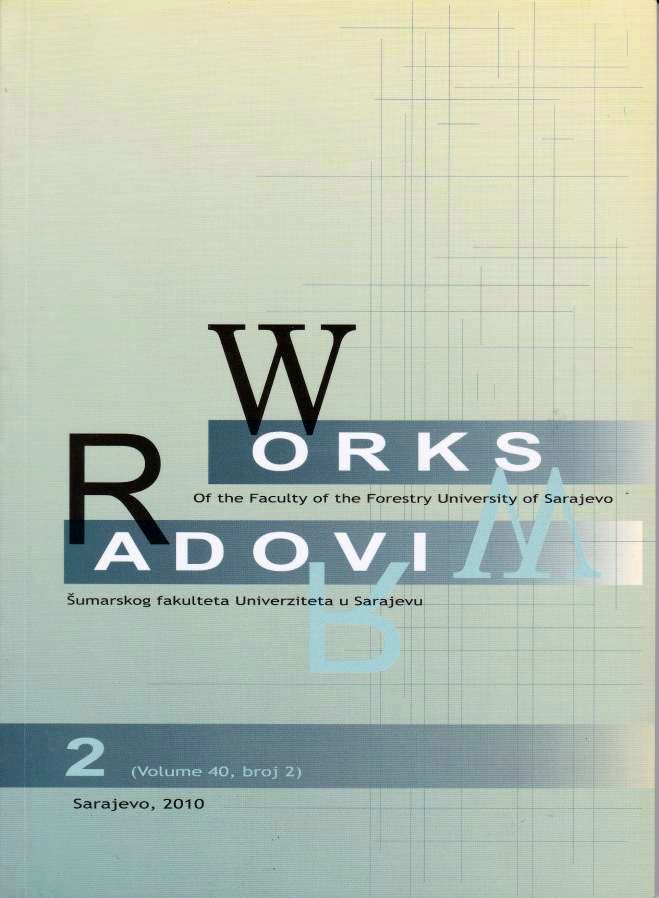Development of a method for the spectrophotometric determination of arsenic
DOI:
https://doi.org/10.54652/rsf.2010.v40.i2.147Keywords:
arsenic, hydride generation, spectrophotometry, forest soilAbstract
UDK 546.19:543.422.3
The aim of this work was to develop a simple and inexpensive method at low ppb levels for the determination of arsenic in soils. A device SupraLab FD was used for analysis, and it presents improved version of an instrument previously designed for the determination of inorganic arsenic in drinking water. A new analytical procedure was developed, and it is based on hydride generation of arsenic from acidic sample solution. Hydride generation of arsenic was performed with two tablets of amidosulfonic acid (3,5600 g of pure acid) and one tablet of sodium borohydride (0,300 g of borohydride in 5g of sodium chloride matrix). The hydride formed during the reaction passed through filter paper, and reacted with mercury bromide giving a colored compound, which was optically detected. Optimization of experimental parameters was done with standard solutions of arsenite and arsenate, and calibration curves were established. A calibration plot fitted with quadratic function for concentration range of arsenic 0,2 -60 µg/dm3 was obtained. Higher precision was observed for concentration range 0-20 µg/dm3 with following coefficients: a = 1,036×10-3, b = 0,031, and c =- 3,181×10-4 with correlation factor of r2 = 0,9995. The relative standard deviation (RSD) of signal decrease (ΔU) for 10 µgAs/dm3 was determined as ±2,8 % for As(III), and ± 2,6 % for As(V). Limit of quantification was 0,2 µgAs/dm3, and the detection limit (3s value) was 0,06 µgAs/dm3.
Validation of the method was done by analysis of arsenic in forest soil samples applying a reference standard material (Montana Soil 2710), and interlaboratory comparison with ICP-MS method. The recoveries for the samples calculated according to data obtained with ICP-MS were between 92,0% and 95,0% which is in good agreement for the field device.
Downloads
References
ADRIANO, D.C. (1986): Trace Elements in the Terrestrial Environment. 1st ed., Springer-Verlag, Berlin.
AGGETT, J., ASPELL, A.C. (1976): The determination of As(III) and total inorganic arsenic by atomic absorption spectrometry. Analyst, 101: 341-347.
ALLOWAY, B.I. (1995): Heavy Metals in Soils. 2nd ed., Blackie Academic &Professional, London.
BERMAN, E. (1991): Toxic metals and their analysis. 2nd ed., Heyden, London, UK.
CULLEN, W.R., REIMER, K.J. (1989): Arsenic speciation in the environment. Chemical Reviews. 89 (4): 713–764.
DRIEHAUS W., JEKEL, M. (1992): Determination of As(III) and total inorganic arsenic by on-line pretreatment in hydride generation atomic absorption spectrometry. Fresenius´ Journal of Analytical Chemistry, 343: 352-356
FRESENIUS, W., QUENTIN, K.E., W. SCHENDEIR W. (1988): Water Analysis. 1st ed., Springer -Verlag, Berlin.
HASSWEEL, S.J. (1991): Atomic Absorption Spectrometry. 1st ed., Elsevier, Amsterdam.
KABATA-PENDIAS A., PENDIAS H. (1984): Trace Elements in Soils and Plants. 1st ed., CRC Press Inc. USA.
LOPEZ, A., TORRALBA, R., PALACIOS, M.A., CAMARA, C. (1992): Generation of AsH3
from As(V) in the absence of KI as prereducing agent: Speciation of inorganic arsenic. Talanta, 39 (10): 1343-1348
MODEREGGER, H. (1998): Development of a New Device for the Determination of Arsenic. Master thesis. Karl-Franzens University, Graz, Austria.
NORMAN, N.C. (1998): Chemistry of Arsenic, Antimony and Bismuth. 1st ed., Blackie Academic &Professional, London.
SCHENK, F. (1989): Quantitative Analytische Chemie. 4th ed., Wieweg, Braunschweig.
SEILER, H.G., SIGEL, A., SIGEL H. (1994): Handbook on Metals in Clinical and Analytical Chemistry. Marcel Dekker, Inc., New York.
SHRAIM, A., CHISWELL B., OLSZOWY, H. (2000): Use of perchloric acid as a reaction medium for speciation of arsenic by HG-AAS. Analyst, 125 (5): 949-953.
STEC, K., BOBROWSKI, A., KALCHER, K., MODEREGGER H., W. GOESSLER, W. (2006): Determination of Arsenic in Dolomites with a Simple Field Spectrometric Device. Microchimica Acta, 153: 45-49.
TORRALBA, R., BONILLA, M., PALACIOS, A., CAMARA, C. (1994): Flow injection and continuous flow system to determine arsenic species As(III) and As(V) by HG AAS. Anlusis, 22: 478-482
WELZ, B. (1998): Speciation analysis. The future of atomic absorption spectrometry.
Journal of Analytical Atomic Spectrometry, 13: 413-417.






















